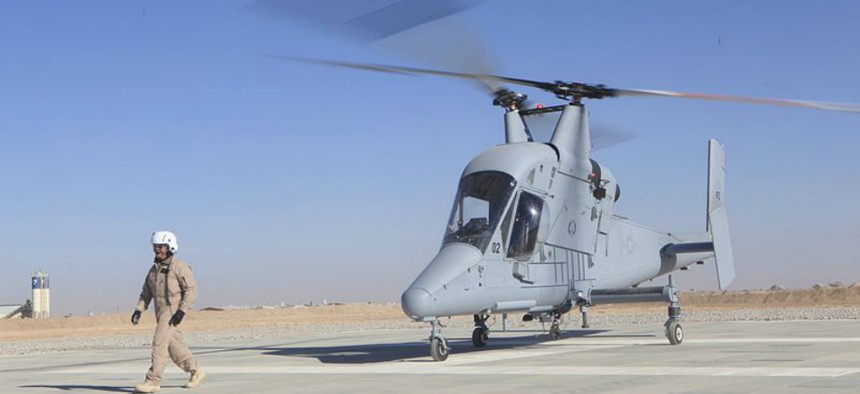
An unmanned variant of the K-MAX U.S. MARINE CORPS PHOTO
This Robot Military Supply Helicopter Could Soon Be Fighting Wildfires
The K-Max has performed well in supplying troops in Afghanistan. Now it could help fight fires around the world. By Patrick Tucker
The robotic K-MAX medium lift helicopter proved very effective in Afghanistan where, in 33 months of war, the Marines successfully completed some 2,000 cargo and supply sorties with just two of the unmanned birds. “From our standpoint, we were able to take convoys off the road and our soldiers out of harm’s way,” said Greg Steiner, president of Kaman Aerospace Group, which makes the rotary aircraft. Lockheed Martin makes the vehicle's unmanned system.
The K-MAX has now found a new mission – fighting fires.
On Nov. 5, Kaman and Lockheed Martin tested a robotic version of the helicopter at an airfield in upstate New York. A small Indago quadrotor drone used its electro-optical/infrared sensors to spot a rapacious fire burning in a canister and then sent information to a human operator on the ground. The operator then dispatched an unmanned K-MAX helicopter to put out the fire. With virtually no guidance other than a pre-programmed flight path, the K-MAX, carrying 3,000 gallons of water, deposited its payload to extinguish the flame in one hour.
Drones have been deployed in firefighting missions before but the demonstration at Rome, New York's Griffiss International Airport marks the first successful test of an autonomous drone in a firefighting scenario.
The test also signals a big debut for an aircraft that played an important -- but largely unsung -- role in the most dangerous parts of Afghanistan, resupplying forward operating bases and remote combat outposts.
Autonomous systems like the K-MAX could effectively double the number of helicopter pilots on hand to fight forest fires. “The aircraft could be flown manned during the day, unmanned at night or in bad weather to support 24-hour fire fighting,” said Steiner.
The successful demonstration of the K-MAX in New York suggests that the robotic helicopters could play a bigger role in a wider number of the humanitarian missions that are falling to the military, such as managing relief and supply delivery in Ebola-stricken West Africa.
The cost of flying the K-MAX is $1,300 per flight hour.
The K-MAX won’t be the only autonomous helicopter in the skies in the future. You could soon be able to retrofit a wide variety of existing helicopters with autonomous guidance systems, thanks to an Office of Naval Research program called the Autonomous Aerial Cargo/Utility System (ACCUS), revealed earlier this year. The ACCUS system turns virtually any helicopter into a near autonomous, unmanned system that can be summoned with the press of a button.
Not only are pilots increasingly superfluous to various high-stakes missions so too, increasingly, are drone operators. Robots could be called on to make and more decisions in emergency missions and perhaps, one day, in combat if the Pentagon develops the political will to overturn the 2012 directive that prohibits autonomous systems from making life or death decisions.
In the meantime, the K-MAX could be fighting fires near you as early as the 2015, summer fire season.




